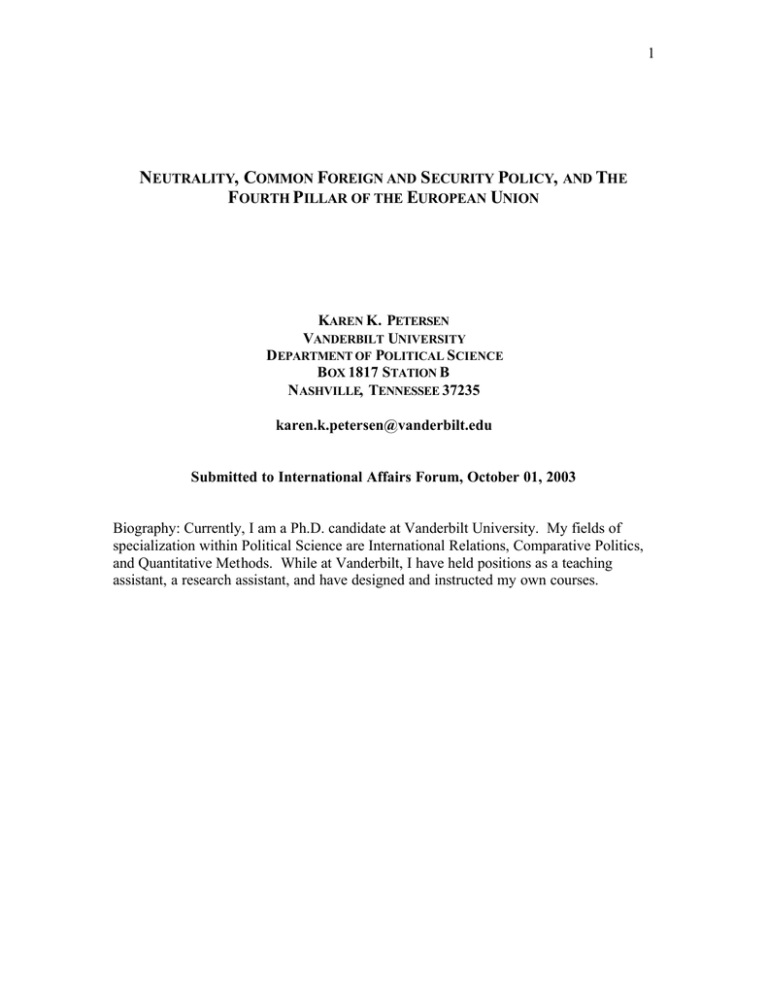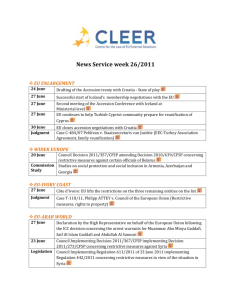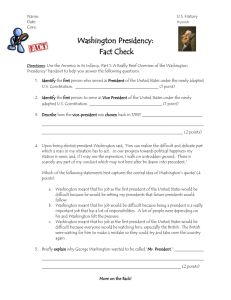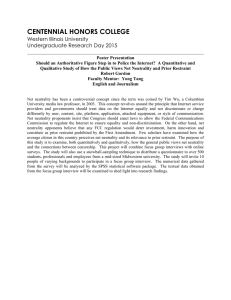N , C F
advertisement

1 NEUTRALITY, COMMON FOREIGN AND SECURITY POLICY, AND THE FOURTH PILLAR OF THE EUROPEAN UNION KAREN K. PETERSEN VANDERBILT UNIVERSITY DEPARTMENT OF POLITICAL SCIENCE BOX 1817 STATION B NASHVILLE, TENNESSEE 37235 karen.k.petersen@vanderbilt.edu Submitted to International Affairs Forum, October 01, 2003 Biography: Currently, I am a Ph.D. candidate at Vanderbilt University. My fields of specialization within Political Science are International Relations, Comparative Politics, and Quantitative Methods. While at Vanderbilt, I have held positions as a teaching assistant, a research assistant, and have designed and instructed my own courses. 2 Is the Fourth Pillar a Viable Solution to the CFSP Debate? Despite the often emphasized economic beginnings and ultimate aims of the EU and many of its policies, Europe’s attempt to centralize stems from the political goal of the eradication of war from the continent. Europe was plagued with almost continuous military struggle from the beginnings of modern civilization through the end of the Second World War. 1 The first attempt at centralizing security, the Concert of Europe, failed with the outbreak of the Crimean War, which led to the subsequent conflicts that eventually culminated in World War II. In the aftermath of World War II, the realization that Europe could no longer bear the costs of such continuous bloodshed—physically or financially—led to the formation of the European Coal and Steel Community (ECSC)2 . Simply put, all of the economic and social consequences of unification are a by-product of the quest for stability and peace—making the Common Foreign and Security Policy an integral part of the foundation for European integration. Why then, has the establishment of a Common Foreign and Security Policy (CFSP) been so troublesome for the European Union (EU)? Security and defense are seen—both theoretically and practically—as falling entirely in the domain of the nation state. The norms of sovereignty and territorial integrity that developed with the rise of the Westphalian system still dominate the political landscape of international politics. The attempts by the EU to incorporate the responsibility for security and defense into a supranational structure go against a well-established system of norms. It should come as no surprise then that the road towards a common foreign and security policy has been 1 See Wawro, 2000, for an overview of the military struggles from Napoleon through the outbreak of World War I. 2 Ironically, it was in the Prisoner-of-War camps that the ideas for European unification took hold and fermented (Duke 2000, 12). 3 bumpy at best. The real marvel is that the EU has managed to make as much progress in this area as it has to date. This study represents an attempt to deal with one of the bumps on the road to a CFSP—neutrality. The Neutral Non-Aligned (NNA) states represent special cases in the debate over the CFSP and are deserving of individual attention. Herein, I will discuss why these cases are different, how the NNA status of these cases affects their propensity to accept a CFSP, as well as the viability of one proposed solution—the Fourth Pillar. Background on CFSP Development As mentioned above, European integration is by no means a “new” idea, and the foundation for integration is built upon the goal of eradicating interstate warfare from what has been the most violent region in history. The process of integration, however, has not always paralleled the theory. In fact, European integration usually appears more functional than elaborately planned. For example, in the aftermath of the September 11 attacks, the EU member states accepted the legitimacy of an EU arrest warrant in order to track down and arrest suspected terrorists. In Duke’s analysis of the CFSP, a functionalist argument is apparent. He argues, as only one of many examples, that “The reluctance to consider CFSP questions in the early 1990s only changed as a number of successive developments in Europe altered the context of European security” (117), and continues on to cite the breakup of the USSR, the crises in Yugoslavia, German re-unification, and the return of the importance of domestic politics to the U.S. political agenda as the primary examples. The functionalist approach is particularly appealing in that “the beneficiaries of 4 integrative steps achieve vested positions in the system such that a return to an earlier mode of action is undesirable” (Haas 1968, xxix; cited in Duke 2000, 10). 3 A brief historical account 4 of the progress towards a CFSP begins with the establishment of the European Defence Community (EDC) in 1952-4. France failed to ratify the treaty because of disagreements over Germany’s role in the EDC. The Fouchet Plan (1962) followed, but was also rejected—this time as too intergovernmental. The Hague Summit (1969) formally called for a united Europe capable of dealing with all issues including security. Following the Hague Summit were the Luxembourg, Copenhagen, and London Reports (1970-1981) all of which clarify policies with regard to European Political Cooperation (EPC), which were then institutionalized by the Single European Act (SEA) (1986). Article 30 of the SEA additionally specified that members who participate in international organizations to which all EU members are not party (the UN security council, for example) are required to take into account the positions agreed to in EPC. The Treaty on European Union (TEU) (1992) formally establishes the CFSP as the second pillar of the EU, including security as a formal part of cooperation. Finally, the Treaty of Amsterdam (1997) calls for the application of the CFSP to all questions of security and clarifies the procedures of the Western Europe Union (WEU). While incremental, the progress towards a CFSP has been noticeable. With a task as daunting and as threatening to state sovereignty as the placement of defense and security in the hands of a supranational organization, patience is certainly a virtue. 3 For an interesting discussion of the importance of the status quo as a reference point, see the literature on Prospect Theory (Levy 1992; Quattrone and Tversky 1988, and Weyland 1996). 4 The timeline is taken from Appendix 9 of Duke 2000, 353. Detailed discussions of these events are included in Duke as well as many of the sources in the bibliography. 5 Therefore, while progress may accrue at a “snail’s pace,” (Duke 2000, 11) snails reach their destinations with deliberation and caution—not undesirable characteristics when discussing military and security issues. Security and Defense—Two Distinct Components? Security in the post Cold War era has taken on a variety of meanings, ranging from threats to physical survival (such as terrorism) to environmental threats and encompassing such diverse themes as migration and human rights. The Cold War overshadowed many of these neo-traditional threats, and they have since re-entered the debates, allowing NATO and the UN to justify a variety of actions in the name of global security. Defense, on the other hand, remains clearly in the hands of the nation state. According to Duke, The right of self defence is not only a recognized legal right, but the size and qualitative power of the armed forces with which to defend the nation state are often a source of national identity and pride. … In spite of the fact that none of the EU Member States face a direct military thr eat, the idea of merging national forces … remains premature. … defence integration is coloured by historical suspicions, resentments, and misperceptions that have been held for fifty years or, often, longer. (2000, 5) Clearly, participation in security arrangements and defense arrangement hold different meanings for the EU member states, particularly the NNAs. While the NNAs may be willing to participate in Petersburg (peacekeeping) tasks, they are not as willing to associate with other obligations (Duke 2000, 6). While the distinction between security and defense appears to be academic at first glance, it is of critical importance upon reflection and even more so when the Fourth Pillar is discussed below. For example, the Irish interpretation of the 6 CFSP and the acceptance thereof hinges on just such a distinction. Because security is in the realm of the EU and defense in the realm of the WEU, Ireland can accept the former without being obliged to join the latter, leaving Ireland’s neutrality tradition intact (Fanning 1996, 146). Therefore, it is with the caveat that security and defense are two very separate components of a workable CFSP that I proceed to the discussion of the next concept—neutrality. Neutrality What is neutrality? Neutrality as a policy “can variously be either passive or active, ad hoc or de jure. It has managed to change from a rather one-dimensional concept, with a short life and an exclusive concern for security policy, to a permanent status with proactive orientation and, very often, an all embracing remit” (Cox and Mac Ginty 1996, 124). From war avoidance in specific instances to conflict avoidance in all instances, neutrality is predicated on the concept of independence of foreign policy and on territorial sovereignty. However, “the rights and duties associated with the norms of neutrality were based on tacit agreements and systems of mutual expectations. Not only were belligerents expected to respect the independence and territorial integrity of the neutral state, a number of duties were asked of the neutral. Trevor Salmon makes the point, ‘that a simple pious declaration is not enough’” (Cox and Mac Ginty 1996, 124). Neutral states, however, were not expected to remain defenseless and often maintained sufficient arms to protect their neutrality (125). Given the above definition of neutrality, who are the real neutrals? Switzerland, Austria, Holland, Belgium, Norway, Sweden, Denmark, Finland, and Ireland have all adopted neutrality at some point in the twentieth century (Cox and Mac Ginty 1996, 122). 7 Switzerland, Holland, and Norway are not members of the EU, and can thus be excluded from consideration herein. Belgium, as a member of the WEU, cannot be regarded as a neutral in the post-cold war era, leaving Austria, Sweden, Denmark, Finland, and Ireland. Is Neutrality Compatible with the Goal of European Integration? “The accession of three EFTA countries on 1 January 1995 posed a number of issues with regard to NATO, but made little difference to the CFSP since Title V is, supposedly, not incompatible with neutrality” (Duke 2000, 274). Additionally, if neutrality is based on the premise of non-alignment, then the assumption is that there is a hostile bloc against whom one can align. In the post Cold War era, that assumption can easily be called into question. The functionalist approach would not rule out a shift in the meaning of neutrality that could incorporate a collective defense. As things stand, however, the NNAs clearly place the responsibility for security and defense in the nation-state. Consider Table 1 below: 8 Table 1: Decision-making Responsibility in the EU Do you think decisions should be made by the national government or jointly within the EU for the following issues? Defense Humanitarian Foreign Aid Policy Nat. EU Nat. EU Nat. EU Austria 56% 38% 45% 51% 35% 58% Denmark 65% 32% 43% 54% 41% 55% Ireland 69% 25% 27% 66% 25% 66% Finland 90% 7% 49% 46% 35% 59% Sweden 73% 24% 58% 38% 42% 54% Germany** 37% 57% 29% 66% 18% 75% France 47% 50% 23% 74% 21% 74% U. K. 64% 27% 36% 55% 36% 52% EU15 46% 48% 28% 67% 22% 69% *The difference between Nat. and EU represents the percentage of “don’t know.” From “Eurobarometer: Public Opinion in the European Union.” April 2000 (52). Pages B.38 to B.40. Fieldwork conducted October-November 1999. **East and West combined. A majority of those surveyed in all of the NNAs clearly place responsibility for defense in the hands of their national governments while at the same time granting leeway to the EU for foreign policy decision making and, for the most part, humanitarian aid decisions. The three major powers, however, grant far more leeway to the EU in all areas including defense (with the exception of the U.K. on defense). The survey results underscore three important points that serve as the centerpieces for the research herein. First, the NNAs are different and deserving of analysis with regard to the issues of security and defense integration. Second, there exists a clear need to separate security and defense. The two concepts do not fall under the same heading with respect to the public’s perception. Third, public opinion in the NNAs will make the enhancement of a 9 CFSP under the current EU structure very difficult, suggesting that the solution to the problem of CFSP acceptance may be structural. At minimum, neutrality will not suffer at the expense of integration when onethird of the EU members consider themselves to be neutral. The development of a CFSP might, however. Therefore, the Fourth Pillar approach offers a possible alternative to the current a la carte participation in EU foreign policy. The Fourth Pillar Essentially, the CFSP is dead in the water due to the connection of defense with the second pillar. The idea of a standing European army does not sit well given the less than peaceful past of European great power relations, and the defense component in the second pillar leads quite naturally to a standing army. On the other hand, resistance to the security component of the second pillar has not been an obstacle for the CFSP. One of the leading opponents of a standing European army has been Britain. Britain’s strong ties with the U.S. have made the issue of a European army even more controversial. The Conservative Party suffered divisions based on the “Europe question” leading eventually to the election of Tony Blair from the Labour Party. Tony Blair held the EU presidency from 1 January to 30 June 1998, and shortly thereafter proposed the creation of a Fourth Pillar to deal with the issue of defense. The idea of a Fourth Pillar is based on a proposal by Charles Grant and subsequent elaboration by Robert Cooper (Duke 2000, 308). Basically, the Grant proposal called for Britain to take the initiative and assume a more prominent role in promoting an EU defense strategy. “By reversing the traditional hostility to the concept of European 10 defence and Britain’s tendency to line up with the US, Grant contended that Britain could radically redefine its role and image in Europe” (Duke 2000, 308). Essentially, Grant’s proposal5 calls for four things. First, Britain needs to strengthen European defense without alienating the US and improve bilateral ties with France simultaneously. Second, Britain should work to reintegrate France into the NATO command structure. Third, Britain should take the lead in creating a European defense industry. Finally, and most importantly, “Britain should propose the abolition of the WEU. Its political functions would merge with the EU, becoming the ‘fourth pillar’, and its military functions would be subsumed into NATO and Article V of the Modified Brussels Treaty (obliging members to defend each other from attack) would be transferred to the fourth pillar” (Duke 2000, 309). The structure of the EU would then be as follows: The European Union 1 st Pillar European Commission --EEC --EURATOM --ECSC 2 nd Pillar 3 rd Pillar 4 th Pillar Common Foreign & Security Policy Police & Judicial Cooperation in Criminal Matters --inc. Schengen Common Defence Policy --ESDI + Art. V of the Modified Brussels Treaty Adapted from Duke 2000, 310. The Fourth Pillar proposal addresses some of the most contentious issues surrounding the CFSP. First, the separation of defense and security allows countries such 5 Paraphrased from Duke 2000, 309. 11 as the NNAs to actively and fully participate in security and foreign policy diplomacy without compromising their neutrality. The Baltic countries stand to benefit as well since they could theoretically join the EU without committing to the Fourth Pillar and thus avoid alienating Russia. Second, abolishing the WEU and strengthening NATO through the Fourth Pillar allows the U.S. to maintain an active security role in Europe and enhances trans-Atlantic cooperation—an issue of high importance to Britain. Finally, Europe’s foreign policy positions would be enhanced by the backing of a military component (Duke 2000, 309).6 The Fourth Pillar proposal may offer the solution to one of the most vexing problems in European integration. However, to date no one has analyzed the acceptability of the proposal from the perspective of some of the members who have been the most ardent opponents of a EU defense—the NNAs. One of the problems faced by the NNA countries is that of domestic public opinion. In all cases, there exists a strong tradition of neutrality that is based on historical precedent. Public opinion does not change rapidly, and memories of a not so peaceful Europe still linger. Thus, any consideration of the feasibility of the development of a viable CFSP through the Fourth Pillar proposal must consider both domestic and international factors. One of the breakthrough theoretical developments in this area was Putnam’s two- level games theory (1988). 6 However, the financial resources of the EU have gone a long way towards achieving respectability for its foreign policy, suggesting that liberal theory might offer an interesting lens through which to view the current situation in the EU. 12 Putnam’s Two -level Games When Cox and Mac Ginty state that “In effect, neutrality can be increasingly regarded as an empty, irrelevant policy option” they fail to consider Level II politics. Essentially, neutrality plays an important domestic role regardless of its impotence on the international stage. It is precisely the importance of domestic politics that needs to be considered in an analysis of the future of a CFSP for the EU. Foreign policy has for too long been considered an elite process. As Duke observes: The French and Danish referenda not only illustrated the extent to which elites were out of touch with their publics, but posed the logical corollary that, having ignored public opinion for so long, elites had little idea of how much policy legitimacy was needed to make further integration publicly acceptable. This observation applies with more force to foreign and security policy since, more than other aspects of integration, it has historically been ‘a private club, operated by diplomats for diplomats, and some of the same ambiance has persisted to this day’. (2000, 119) International relations theory has a long tradition of ignoring domestic politics—a tradition that has been questioned by scholars (see for example Rosenau 1969, Allison 1971, Keohane and Nye 1977, Katzenstein 1976), but not until Putnam’s (1988) parsimonious and elegant treatment did the notion of the interplay between domestic forces and international negotiation gain more widespread acceptance. Essentially, “the two- level approach recognizes that central decision- makers strive to reconcile domestic and international imperatives simultaneously” (Putnam 1988, 460), which in itself is not groundbreaking. The contribution by Putnam is his detailed explanation of the structure of decision-making games and the interplay between the international and domestic levels (Levels I and II, respectively). Putnam’s discussions of win-sets and their use in 13 negotiations sheds much needed light on what decision makers have known all along— domestic situations are not irrelevant to bargaining in international ne gotiations. Putnam recognizes that the literature on European integration that preceded his work was sensitive to the domestic factors affecting negotiation7 , and gives particular credit to Haas for emphasizing the role of interest groups and parties on decision- making (431). It was, Putnam claims, the focus on integration rather than policy making that led this literature to a premature end. The two- level game framework focuses on the negotiation process rather than the development of supranational institutions and thus avoids becoming irrelevant when integration does not proceed at full speed. Putnam’s framework thus serves as a potentially fruitful lens through which to study the acceptance (or not) of a CFSP for the EU—particularly for the NNAs whose representatives face considerable domestic opposition to EU defense. Conclusion It is important to address the future of the CFSP for several reasons. First, security threats have taken on many new faces since the end of the Cold War, and the attacks of September 11, 2001, clearly demonstrated the need for a strong EU in the foreign policy arena. Until the EU enjoys foreign policy coherence, Europe cannot realize its full potential in international politics. Second, the situation in Europe’s “near abroad” is likely to remain a concern for some time. A strong Europe benefits not only Europe, but the U.S. and Russia also. An EU that can respond to crises militarily as well as financially not only ameliorates the burden carried by the U.S., but also enhances the prospect for regionally feasible policies. 7 Putnam cites Deutsch 1957 and Haas 1958. 14 Finally, the CFSP is the foundation and capstone of European integration. All of the economic and social consequences of unification are a by-product of the quest for security and peace—making the CFSP the foundation for European integration. Solid support for the CFSP would go a long way towards ensuring peace in Europe—making all of the goals of integration possible and making the CFSP the capstone of European integration. Bibliography and Selected Sources for Further Reading Allison, Graham T. (1977) Essence of Decision: Explaining the Cuban Missile Crisis. Boston: Little Brown. Bronstone, Adam. (2000) European Security into the Twenty-first Century: Beyond traditional theories of international relations. Aldershot: Ashgate. Cox, Michael, and Roger Mac Ginty. (1996) “Farewell to a Beautiful Idea: The End of Irish Neutrality in the Post-Cold War World.” In Small States and the Security Challenge in the New Europe. Werner Bauwens, Armans Clesse, and Olav F. Knudsen, eds. London: Brassey’s, 122-136. Deutsch, Karl W. (1957) Political Community in the North Atlantic Area: International Organization in the Light of Historical Experience. Princeton: Princeton University Press. Duke, Simon. (2000) The Elusive Quest for European Security: From EDC to CFSP. London: Macmillian Press. European Commission. (1999) “The Amsterdam Treaty: A Comprehensive Guide.” <http://europa.eu.int> Luxembourg: Office for Official Publications of the European Commission. --. (2000) “Eurobarometer: Public Opinion in the European Union.” <http://europa.eu.international/comm./dg10/epo>. Fanning, Ronan. (1996) “Neutrality, Identity, and Security: The Example of Ireland.” In Small States and the Security Challenge in the New Europe. Werner Bauwens, Armans Clesse, and Olav F. Knudsen, eds. London: Brassey’s, 137-149. Furdson, Edward. (1980) The European Defence Community: A History. New York: St. Martin’s Press. 15 Ginsberg, Roy H. (1989) Foreign Policy Actions of the European Community: The Politics of Scale. Boulder, CO: Lynne Reiner. Haas, Ernst B. (1968) The Uniting of Europe: Political, Social, and Economic Forces, 1950-1957. Stanford: Stanford University Press. Holland, Martin, ed. (1997) Common Foreign and Security Policy: The Record and Reforms. London: Pinter. Hook, Stephen W., ed. (2002) Comparative Foreign Policy: Adaptation Strategies of the Great and Emerging Powers. Upper Saddle River, NJ: Prentice Hall. Katzenstein, Peter J. (1976) “International Relations and Domestic Structures: Foreign Economic Policies of Advanced Industrial States.” International Organization 30 (Winter): 1-45. Keohane, Robert O., and Joseph S. Nye. (1977) Power and Interdependence. Boston: Little Brown. Levy, Jack. (1992) “Prospect Theory and International Relations.” Political Psychology. 13: 283-310. Moynihan, Maurice, ed. (1980) Speeches and Statements by Eamon de Valera 1917-73. Dublin. Petersen, Nikolaj. (1996) “Danish Security Policy After the Cold War: Adaptation and Innovation.” In Small States and the Security Challenge in the New Europe. Werner Bauwens, Armans Clesse, and Olav F. Knudsen, eds. London: Brassey’s, 150-170. Putnam, Robert D. (1988) “Diplomacy and domestic politics: the logic of two- level games.” International Organization 42(3): 427-460. Quattrone, George A., and Amos Tversky. (1988) “Contrasting Rational and Psychological Analyses of Political Choice.” American Political Science Review 82 (3): 719-736. Rosenau, James, ed. (1969) “Towards the Study of National-International Linkages.” In Linkage Politics: Essays on the Convergence of National and International Systems. New York: Free Press. Salmon, Trevor. (1989) Unneutral Ireland: An ambivalent and unique security policy. Oxford: Oxford University Press. 16 Wawro, Geoffrey. (2000) Warfare and Society in Europe, 1792-1914. London: Routledge. Weyland, Kurt. (1996) “Risk Taking in Latin American Economic Restructuring: Lessons from Prospect Theory.” International Studies Quarterly 40 (2): 185-208.




